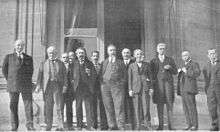Supreme War Council
The Supreme War Council was a central command based in Versailles that coordinated the military strategy of the principal Allies of World War I: Britain, France, Italy, the US and Japan.[1] It was founded in 1917 after the Russian revolution and with Russia's withdrawal imminent.[2] The council served as a forum for preliminary discussions of potential armistice terms as well as peace treaty settlement conditions, and it was succeeded by the Conference of Ambassadors.

Formation
British Prime Minister David Lloyd George had grave concerns regarding the strategy of Sir William Robertson, Chief of the Imperial General Staff, and Sir Douglas Haig, the Commander in Chief of the British Expeditionary Force, in response to the Allied losses at the Somme and at Battle of Passchendaele.
Following the Italian defeat at the Battle of Caporetto, in which the Germans and Austro-Hungarians surprised the Italian forces, Lloyd George proposed the formation of the Supreme War Council at the Rapallo Conference of 5–7 November 1917.
Japan and Russia were not to be included, and the Italians and French, worried that Salonika might be evacuated, wanted it confined to the Western Front.[3]
Permanent Military Representatives
Each Allied nation would also appoint a senior military officer as Permanent Military Representative. The French PMR was Ferdinand Foch, later replaced by Maxime Weygand and Joseph Joffre. The British were represented by Sir Henry Hughes Wilson. Italy was represented by Luigi Cadorna.
The USA, which was "Associated" with the Allies, was not involved with the political structures, but sent a Permanent Military Representative, Tasker H. Bliss.[4]
Wilson and his staff conducted numerous research projects into offensives against Turkey, culminating in the "Joint Note 12".[5]
At the Supreme War Council (30 January – 1 February) Hankey recorded that the national Commanders-in-Chief, national Chiefs of Staff and PMRs "all gave different advice" creating "a worse state of chaos than I have ever known in all my wide experience". Lloyd George, whose main goal was to thwart Robertson, blocked a suggestion by Foch (French Chief of Staff) that the proposed Allied Reserve be controlled by the national Chiefs of Staff, possibly prompted by the notes Wilson was passing him across the table. It was eventually agreed that Foch should command the Reserve, with Wilson as his deputy.[6]
The Allied Reserve eventually slipped from the agenda as the Commanders-in-Chief, Haig and Pétain refused to hand over sufficient troops. Early in 1918 Wilson replaced Robertson as CIGS and at the end of March Foch became Allied Generalissimo. After April 1918 all Allied troops on the Western Front were placed under the command of the Grand Quartier général des armées alliées (GQGA), a multi-national general staff that developed from the Supreme War Council. The GQGA was on similar lines to the GQG and came under General Ferdinand Foch, who had overall command of all Allied troops.[7] Without its two main personalities the military machinery at Versailles became less important.
Meetings
14–16 January 1920 in Paris, France
This meeting was held four days after the ratification of the Treaty of Versailles. Lloyd George proposed dropping the blockade of the Russian Socialist Federal Soviet Republic by starting negotiations with the "Russian people" in the form of the centrosoyuz, which at that time was not controlled by the Bolsheviks. This was agreed, with a communique from the Council being published on 16 January. In the event, the negotiations soon became simply between the United Kingdom and a bolshevised centrosoyuz, leading to the Anglo-Soviet Trade Agreement.
6–16 July 1920 in Spa, Belgium
This was attended by German delegates to discuss war reparations. Related documents:
- "Agreement between the Allies for the settlement of certain questions as to the application of the Treaties of Peace and complementary agreements with Germany, Austria, Hungary and Bulgaria"[8]
- "Protocol of the Conference at Spa on July 16, 1920"[9]
- "Inter-Allied Agreement in regard to advance to the German Government in accordance with Protocol of July 16 regarding coal deliveries"[10]
References
- Renshaw, Patrick (2014-07-10). The Longman Companion to America in the Era of the Two World Wars, 1910-1945. ISBN 9781317895497.
- Greenhalgh, Elizabeth (2005-12-08). Victory through Coalition: Britain and France during the First World War. ISBN 9781139448475.
- Woodward, 1998, pp191-2
- Woodward, 1998, pp191-2
- Woodward, 1998, pp194-5
- Woodward, 1998, pp197
- Lagarde, Lieutenant Benoît. "Grand Quartier Général des Armées Alliées, 1914–1918" (PDF). Sous-Serie GR 15 NN – Répertoire Numérique Detaillé (in French). Service Historique de la Défense. Retrieved 5 July 2017.
- LG/F/148/4/1 in Lloyd George papers, see /www.portcullis.parliament.uk
- LG/F/148/4/2 in Lloyd George papers, see /www.portcullis.parliament.uk
- LG/F/148/4/3 in Lloyd George papers, see /www.portcullis.parliament.uk
- The Supreme War Council, First World War.com, accessed 6 August 2009
- David R Woodward, "Field Marshal Sir William Robertson", Westport Connecticut & London: Praeger, 1998, ISBN 0-275-95422-6